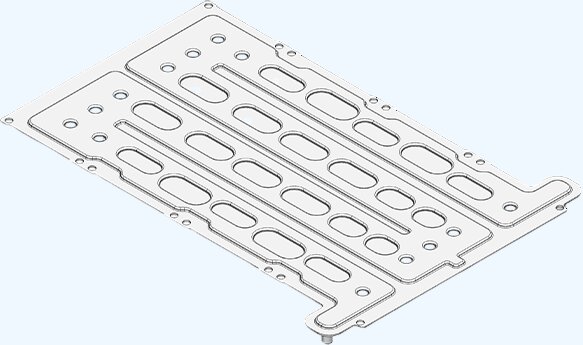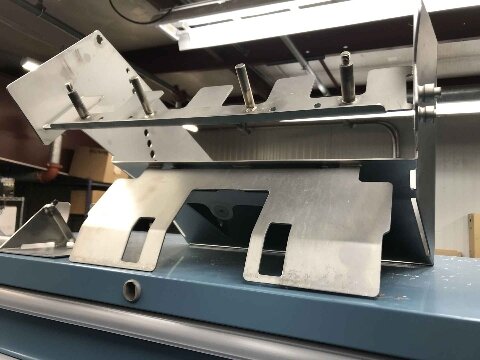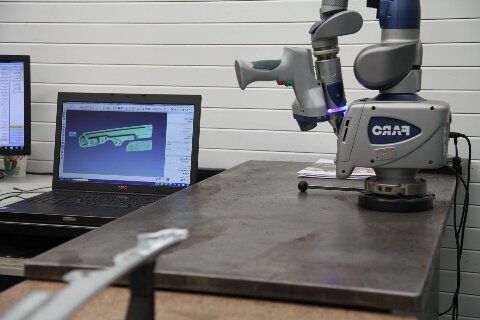스테인리스 스틸 제조업체는 재료의 무결성을 손상시키지 않으면서 복잡한 형상을 만들어야 하는 끊임없는 도전에 직면해 있습니다. 기존 방식은 종종 부족하여 자원 낭비와 수준 이하의 제품으로 이어집니다. 딥 드로잉은 해결책을 제시하지만, 많은 제조업체가 그 잠재력을 최대한 활용하는 데 어려움을 겪고 있습니다.
딥 드로잉은 평평한 스테인리스 강판을 용접이나 접합 없이 3차원 모양으로 변환합니다. 이 기술은 다양한 산업을 위한 매끄럽고 내구성 있는 부품을 만듭니다. 원통형, 상자형 또는 불규칙하게 형성된 구성 요소를 뛰어난 정밀도와 효율성으로 생산하는 데 탁월합니다.
딥 드로잉의 작동 방식과 고유한 과제, 스테인리스 스틸 제조에 대한 놀라운 이점에 대해 알아보세요.

스테인리스 스틸 딥 드로잉 프로세스 이해
딥 드로잉이란 무엇입니까?
딥 드로잉은 평평한 금속판을 속이 빈 3차원 형태로 재구성합니다. 이 프로세스는 금형 위에서 재료를 늘려 이음새나 접합부 없이 복잡한 모양을 만듭니다.
스테인리스 스틸 딥 드로잉에 관련된 단계
딥 드로잉 프로세스는 신중하게 제어되는 일련의 단계를 따릅니다:
- 블랭킹: 스테인리스 강판을 크기에 맞게 자릅니다.
- 윤활: 마찰을 줄이기 위해 특수 윤활제를 적용합니다.
- 그리기: 블랭크는 펀치로 주사위 위로 당겨집니다.
- 다시 그리기: 복잡한 도형의 경우 그리기 과정을 반복할 수 있습니다.
- 트리밍: 최종 제품을 위해 여분의 재료를 제거합니다.
딥 드로잉에 필요한 장비
성공적인 딥 드로잉은 정밀한 기계에 의존합니다:
- 유압식 또는 기계식 프레스
- 맞춤형 설계 금형 및 펀치
- 재료 흐름을 제어하는 블랭크 홀더
- 특수 윤활제
딥 드로잉에서 윤활의 역할
적절한 윤활은 매우 중요합니다. 금속과 금형 사이의 마찰을 줄여 찢어짐을 방지하고 매끄러운 마감을 보장합니다. 당사는 특정 스테인리스 스틸 등급과 원하는 모양에 따라 윤활제를 선택합니다.
딥 드로잉 스테인리스 스틸의 재료 고려 사항
딥 드로잉을 위한 스테인리스 스틸의 주요 특성
스테인리스 스틸의 고유한 특성으로 인해 딥 드로잉에 이상적입니다:
- 연성: 골절 없이 상당한 변형이 가능합니다.
- 작업 강화: 그리기 프로세스 중에 재질을 강화합니다.
- 부식 저항성: 열악한 환경에서도 무결성을 유지합니다.
- 미적 매력: 매력적이고 고품질의 완제품을 생산합니다.
딥 드로잉에 사용되는 일반적인 스테인리스 스틸 등급
모든 스테인리스 스틸 재질이 딥 드로잉에 적합하게 제작되는 것은 아닙니다:
- 304: 성형성과 내식성이 뛰어납니다.
- 316: 뛰어난 강도와 내화학성.
- 301: 유연성이 뛰어나 복잡한 모양에 이상적입니다.
- 430: 페라이트계 스테인리스강으로 성형성이 우수합니다.
특정 지원 요건에 따라 적절한 등급을 선택합니다.
딥 드로잉 스테인리스 스틸 부품의 일반적인 응용 분야
딥 드로잉 스테인리스 스틸은 다양한 산업 분야에서 사용됩니다:
- 자동차: 연료 탱크, 배기 부품
- 항공우주: 엔진 부품, 구조 부품
- 의료: 수술도구, 임플란트
- 식품 가공: 싱크대, 용기, 믹싱볼
- 소비재: 조리기구, 가전제품 하우징
딥 드로잉 스테인리스 스틸의 다재다능함은 그 적용 분야를 계속 확장하고 있습니다.
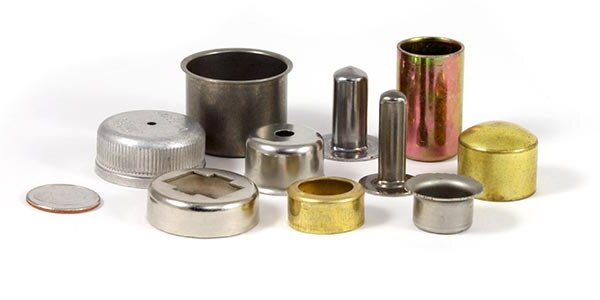
딥 드로잉을 위한 도구 및 장비
스테인리스 스틸 딥 드로잉에는 특수 도구와 장비가 필요합니다. 성공적인 딥 드로잉 작업을 위해 필요한 주요 구성 요소를 분석해 보겠습니다.
딥 드로잉에 사용되는 프레스
유압식 및 기계식 프레스는 딥 드로잉의 주력 제품입니다. 유압 프레스는 정밀한 제어와 속도 조절이 가능합니다. 복잡한 부품과 소규모 생산에 이상적입니다.
반면 기계식 프레스는 대량 생산에 탁월합니다. 더 빠른 사이클 타임과 일관된 힘을 제공합니다.
다이 및 펀치: 디자인 및 재료 선택
금형과 펀치는 딥 드로잉 중 스테인리스 스틸을 성형하는 데 매우 중요합니다. 금형 설계는 최종 제품 품질에 큰 영향을 미칩니다. 잘 설계된 금형은 적절한 재료 흐름을 보장하고 주름이나 찢어짐과 같은 결함을 방지합니다.
금형과 펀치의 재료 선택도 마찬가지로 중요합니다. D2 또는 M2와 같은 공구강이 일반적으로 선택됩니다. 내마모성이 뛰어나고 높은 응력에서도 형상을 유지합니다. 보다 까다로운 응용 분야에는 카바이드 공구가 필요할 수 있습니다.
딥 드로잉에서 도구 유지 관리의 중요성
스테인리스 스틸 딥 드로잉에서 일관된 결과를 얻으려면 정기적인 공구 유지보수가 필수적입니다. 적절한 관리는 공구 수명을 연장하고 부품 품질을 보장합니다.
사용 후에는 매번 도구를 청소하여 이물질을 제거하고 쌓이는 것을 방지하세요. 움직이는 부품에 정기적으로 윤활유를 발라 마찰과 마모를 줄입니다. 마모된 펀치와 다이를 즉시 날카롭게 하거나 교체하세요.
딥 드로잉 성능을 최적화하는 기술
고품질 스테인리스 스틸 부품을 제작하려면 딥 드로잉 기술을 숙달하는 것이 중요합니다. 딥 드로잉 프로세스를 개선하기 위한 몇 가지 핵심 전략을 살펴보겠습니다.
재료 흐름 및 두께 제어
딥 드로잉에서는 적절한 재료 흐름이 중요합니다. 이는 균일한 두께를 보장하고 결함을 방지합니다. 드로 비드를 사용하여 다이 캐비티로의 재료 흐름을 제어합니다. 다이 또는 블랭크 홀더의 돌출된 부분은 저항을 생성하여 재료 이동을 느리게 합니다.
윤활은 재료 흐름에 큰 역할을 합니다. 스테인리스 스틸용으로 특별히 설계된 윤활제를 선택하세요. 그리는 동안 마찰과 열 축적을 줄여줍니다.
드로잉하는 동안 재료 두께를 모니터링합니다. 필요에 따라 펀치 속도와 블랭크 홀더 힘을 조정합니다. 이렇게 하면 파트의 중요한 영역에서 재료가 과도하게 얇아지거나 두꺼워지는 것을 방지할 수 있습니다.
딥 드로잉의 주름과 찢김 감소
주름을 줄이려면 블랭크 홀더 압력을 최적화하세요. 낮은 압력으로 시작하여 서서히 압력을 높입니다. 이렇게 하면 재료 흐름을 제어하면서 과도한 재료가 뭉치는 것을 방지할 수 있습니다.
찢어짐을 방지하려면 복잡한 부품의 경우 다단계 드로잉을 고려하세요. 이렇게 하면 여러 단계에 걸쳐 변형이 분산되어 소재에 가해지는 응력이 줄어듭니다. 펀치와 다이에 모서리 반경을 넉넉하게 사용합니다. 날카로운 모서리는 응력 지점을 만들어 찢어짐을 유발할 수 있습니다.
블랭크 유지력이 최종 제품 품질에 미치는 영향
블랭크 유지력은 최종 제품 품질에 큰 영향을 미칩니다. 힘이 너무 적으면 주름이 생기고, 너무 많으면 찢어질 수 있습니다. 적절한 균형을 찾는 것이 중요합니다.
낮은 블랭크 유지력으로 시작하여 점차적으로 높입니다. 각 단계에서 파트 품질을 모니터링합니다. 주름이나 찢어짐의 징후가 있는지 확인하고 그에 따라 조정합니다.
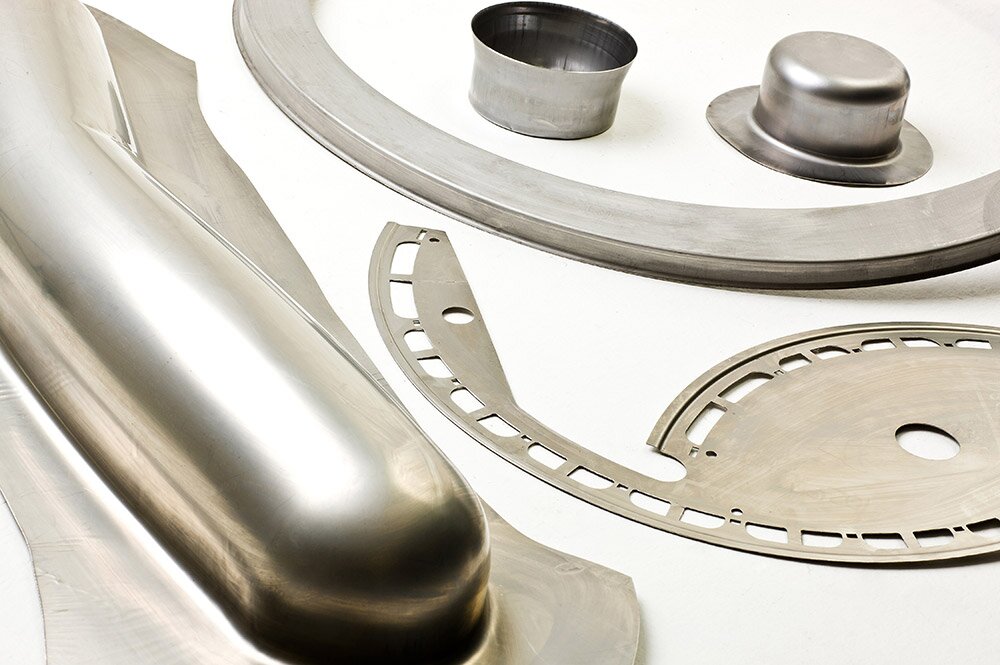
딥 드로잉 스테인리스 스틸의 장점
딥 드로잉 스테인리스 스틸은 다양한 이점을 제공합니다. 많은 제조업체가 이 공정을 최고의 선택으로 삼는 주요 이점을 살펴 보겠습니다.
딥 드로잉 스테인리스 스틸 부품의 비용 효율성
딥 드로잉은 상당한 비용 이점을 제공합니다:
- 가공 공정에 비해 재료 낭비 최소화
- 대량 주문을 위한 빠른 생산 속도
- 다음과 같은 보조 작업의 필요성 감소 용접 또는 가입
- 다른 성형 방법에 비해 단순한 형상에 대한 툴링 비용 절감
이러한 요소들이 결합되어 딥 드로잉은 많은 애플리케이션에서 비용 효율적인 선택이 될 수 있습니다.
딥 드로잉 스테인리스 스틸 부품의 내구성과 강도
딥 드로잉 스테인리스 스틸 부품은 인상적인 기계적 특성을 자랑합니다:
- 균일한 벽 두께로 일관된 강도 보장
- 공정 중 작업 경화는 재료 강도를 증가시킵니다.
- 이음매 없는 구조로 용접 어셈블리에서 발견되는 취약점 제거
- 뛰어난 내피로성으로 오래 지속되는 성능
이러한 특성으로 인해 딥 드로잉 부품은 까다로운 애플리케이션에 이상적입니다.
환경 및 지속 가능성 이점
딥 드로잉은 지속 가능한 제조 관행에 부합합니다:
- 자재 낭비를 최소화하여 원자재 소비량 감소
- 기계 가공이나 주조에 비해 에너지 효율적인 공정
- 수명이 다한 스테인리스 스틸의 재활용 가능성
- 제품 수명이 길어 교체 빈도 감소
딥 드로잉 스테인리스 스틸을 선택하면 제조업체는 환경 발자국을 줄일 수 있습니다.
스테인리스 스틸 딥 드로잉의 도전 과제
딥 드로잉 스테인리스 스틸에는 고유한 도전 과제가 있습니다. 일반적인 문제와 이를 효과적으로 해결하는 방법을 살펴보세요.
딥 드로잉 스테인리스 스틸의 일반적인 결함
스테인리스 스틸의 특성으로 인해 딥 드로잉 시 특정 결함이 발생할 수 있습니다. 이러한 문제를 이해하는 것이 예방의 첫 번째 단계입니다.
주름
주름은 드로잉된 파트의 플랜지나 벽에 과도한 재료가 모일 때 발생합니다. 이는 블랭크 홀더 압력이 충분하지 않거나 부적절한 윤활로 인해 발생하는 경우가 많습니다. 주름이 생기면 파트의 구조적 무결성과 외관이 손상될 수 있습니다.
찢는
찢어짐은 재료가 한계를 넘어 늘어날 때 발생합니다. 일반적으로 깊게 그려진 파트의 바닥이나 모서리에서 나타납니다. 과도한 블랭크 홀더 압력이나 날카로운 공구 모서리가 일반적인 원인입니다. 찢어짐은 부품을 사용할 수 없게 만들고 스크랩률을 높입니다.
귀
이어링은 깊게 파인 컵의 상단에 물결 모양의 가장자리가 생기는 현상입니다. 이는 스테인리스 스틸 시트의 이방성으로 인해 발생합니다. 이어링이 발생하면 부품 높이가 고르지 않게 되며 추가 트리밍 작업이 필요할 수 있습니다.
딥 드로잉 결함을 완화하는 방법
결함을 방지하려면 다각적인 접근 방식이 필요합니다. 도구 설계를 최적화하는 것부터 시작하세요. 시뮬레이션 소프트웨어를 사용하여 생산을 시작하기 전에 잠재적인 문제를 예측하고 해결하세요.
공정 매개변수를 미세 조정합니다. 블랭크 홀더 힘, 펀치 속도 및 윤활을 조정하여 각 부품의 최적 지점을 찾습니다. 드로 비드 또는 스텝 플레이트를 사용하여 재료 흐름을 제어하고 주름을 줄이세요.
복잡한 부품의 경우 다단계 드로잉을 사용하면 응력을 더 고르게 분산시킬 수 있습니다. 이렇게 하면 찢어질 위험이 줄어들고 더 깊게 그릴 수 있습니다. 필요한 경우 단계 사이에 재료를 어닐링하여 유연성을 회복합니다.
스테인리스 스틸이 공구 마모에 미치는 영향
스테인리스 스틸은 연한 금속에 비해 공구에 더 단단합니다. 높은 강도와 가공 경화 특성으로 인해 공구의 마모가 빨라집니다. 따라서 공구를 더 자주 유지보수하고 교체해야 합니다.
적절한 공구 재질을 선택하여 공구 마모를 방지하세요. 고속강 또는 카바이드는 내마모성이 우수합니다. 공구 수명을 더 연장하려면 경질 크롬 도금 또는 질화를 적용하세요.
적절한 윤활이 중요합니다. 스테인리스 스틸 딥 드로잉용으로 설계된 윤활제를 사용하세요. 공구와 공작물 사이에 보호막을 형성하여 마찰과 마모를 줄여줍니다.
딥 드로잉과 다른 금속 성형 공정 비교
효율적인 생산을 위해서는 올바른 금속 성형 공정을 선택하는 것이 중요합니다. 딥 드로잉을 다른 방법과 비교하고 스테인리스 스틸 부품에 가장 적합한 시기를 살펴보겠습니다.
딥 드로잉과 스탬핑 및 하이드로포밍 비교하기
딥 드로잉, 스탬핑, 하이드로포밍은 각각 고유한 강점을 가지고 있습니다. 이러한 차이점을 이해하면 프로젝트에 가장 적합한 프로세스를 선택하는 데 도움이 됩니다.
딥 드로잉은 평평한 판금에서 깊고 원통형 부품을 만드는 데 탁월합니다. 컵, 캔 및 기타 속이 빈 형태를 제작하는 데 이상적입니다. 이 공정을 통해 엄격한 공차와 매끄러운 표면 마감을 구현할 수 있습니다.
스탬핑은 단순한 모양을 대량으로 제작할 때 유용합니다. 딥 드로잉보다 빠르지만 제작할 수 있는 부품의 깊이와 복잡성에 제한이 있습니다. 스탬핑은 브래킷이나 패널과 같이 평평하거나 얕은 구성 요소에 적합합니다.
하이드로포밍은 유체 압력을 사용하여 금속을 성형합니다. 다용도로 사용할 수 있으며 벽 두께가 균일한 복잡한 모양을 만들 수 있습니다. 하지만 일반적으로 딥 드로잉이나 스탬핑보다 속도가 느리고 비용이 많이 듭니다.
스테인리스 스틸 부품에 딥 드로잉을 사용해야 하는 경우
딥 드로잉은 특정 특성을 가진 스테인리스 스틸 부품에 자주 사용됩니다. 필요할 때 딥 드로잉을 고려하세요:
- 깊고 속이 빈 부분: 컴포넌트의 깊이가 지름의 절반보다 큰 경우 딥 드로잉이 가장 좋은 옵션일 수 있습니다.
- 엄격한 허용 오차: 딥 드로잉은 다른 많은 성형 방법보다 더 엄격한 공차를 달성할 수 있으며, 이는 정밀 부품에 매우 중요합니다.
- 매끄러운 표면: 이 공정은 표면 마감이 우수한 부품을 생산하여 2차 작업의 필요성을 줄여줍니다.
- 재료 효율성: 딥 드로잉은 일반적으로 기계 가공 공정보다 재료 사용량이 적기 때문에 대규모 생산에 비용 효율적입니다.
- 복잡한 기하학: 하이드로포밍보다 활용도가 높지만 딥 드로잉은 단순한 스탬핑보다 더 복잡한 모양을 만들 수 있습니다.
결론
딥 드로잉 스테인리스 스틸은 광범위한 응용 분야를 가진 강력한 제조 공정입니다. 복잡하고 내구성이 뛰어난 부품을 효율적으로 생산할 수 있는 고유한 이점을 제공합니다.
이 기술을 사용하면 중량 대비 강도가 뛰어난 이음매 없는 중공 부품을 만들 수 있습니다. 특히 고성능의 내식성 부품이 필요한 산업에서 유용합니다.
신뢰할 수 있는 판금 부품 제조업체가 필요하세요? Shengen이 찾아갈 곳입니다. 저희는 딥 드로잉, 판금 레이저 커팅, 스탬핑, 표면 마감 및 CNC 가공을 전문으로 합니다. Shengen에 연락하세요 오늘 전문가의 도움을 구하세요!
자주 묻는 질문
딥 드로잉 스테인리스 스틸에서 얻을 수 있는 최대 깊이는 얼마입니까?
일반적으로 한 번의 추첨으로 2:1의 깊이 대 지름 비율을 얻을 수 있습니다. 여러 단계를 거치면 10:1 이상의 비율을 달성할 수 있습니다. 정확한 한계는 강철 등급과 두께에 따라 다릅니다.
스테인리스 스틸 등급은 딥 드로잉 공정에 어떤 영향을 미칩니까?
오스테나이트 재종(304, 316)은 유연성 때문에 깊게 그리기가 더 쉽습니다. 페라이트계(430)는 더 까다롭고 추가 어닐링이 필요할 수 있습니다. 마르텐사이트 재종은 강도가 높고 연성이 낮기 때문에 가장 어렵습니다.
딥 드로잉의 최대 두께는 얼마입니까?
최대 두께는 일반적으로 3~4mm(0.12~0.16인치)이며, 강철 등급과 부품 형상에 따라 달라집니다. 재료가 두꺼울수록 더 많은 힘과 특수 장비가 필요합니다.
딥 드로잉에 가장 적합한 금속은 무엇인가요?
저탄소 강재는 높은 연성과 저렴한 비용으로 인해 종종 최고의 강재로 간주됩니다. 알루미늄 합금(1000 및 3000 시리즈)은 성형성과 강도가 우수합니다. 최적의 선택은 특정 애플리케이션 요구 사항에 따라 달라집니다.
안녕하세요, 저는 케빈 리입니다

지난 10년 동안 저는 다양한 형태의 판금 제작에 몰두해 왔으며 다양한 워크숍에서 얻은 경험에서 얻은 멋진 통찰력을 이곳에서 공유했습니다.
연락하세요

케빈 리
저는 레이저 절단, 굽힘, 용접 및 표면 처리 기술을 전문으로 하는 판금 제조 분야에서 10년 이상의 전문 경험을 갖고 있습니다. Shengen의 기술 이사로서 저는 복잡한 제조 문제를 해결하고 각 프로젝트에서 혁신과 품질을 주도하는 데 최선을 다하고 있습니다.

